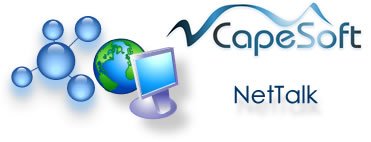The Demo program is the grand-daddy of the NetTalk examples, and incorporates
almost all NetTalk functionality (except the WebServer) in a single application.
It's designed so that you can manually execute the various classes to see what
effect various settings have.
This application is the usual starting point for experimenting with the classes,
and with interacting with other programs.
DialUp Hand Code
A simple example using just the Generic NetDun class, and some hand-code to
prime the various properties.
DialUp Jump Start
DIP
DIP Server
DIP stands for Dynamic IP Addressing. The NetAuto protocol is designed to automatically find and
connect to other (NetAuto) programs on the LAN which are running. This discovery is done via the
UDP broadcast system. If your network is a WAN than an alternate mechanism is needed
for the machines to find each other.
One approach is the DIP system - if all the programs are aware of a DIP server
address, then they can find each other through that address.
This example is the server side of the DIP protocol. This app requires
WinEvent.
NetSimple
NetSimple Auto Packet Boundaries
NetSimpleClient Server
NetSimple Jump Start
NetSimple Manual Packet Boundaries and Encryption
Whole Packet
RSS
RSS Client Jump Start
A simple program that uses the WebClient class to fetch an RSS file from
ClarionMag. The received RSS page is displayed in a 'raw' format as it is
received.
RSS Client with xFiles
Similar to the RSS jump Start, this program parses the incoming RSS information
(using xFiles) and displays it in a list box.
SNMP
SNMP Jump Start
A simple introduction to SNMP, this program fetches the SNMP settings from a
remote machine. This program is the result of following the
SNMP Jump Start instructions.
Web Client
SOAP
The SOAP folder contains two example apps, one which uses
xFiles and one which uses normal Clarion commands to do the XML part. The
example makes use of the
Unit Converter at WebServiceX.net.
Web Client Jump Start
A really simple program that fetches a single page from a web site.
Web Client Polling Agent
A small window which loops through a list of web pages, fetching them one at a
time. You can adjust the pages looked for, as well as the time between checks.
Web Client Weather requires xFiles
The Weather app is designed to interact with the
Global Weather service at WebServiceX.net. It uses
xFiles to convert from Clarion structures to XML and back again. The example
was used as the basis for
Clarion Live webinar #48 which discussed the Webclient class at some length.
The weather application also contains a simple Drive procedure that let's you
manually fetch web pages, inspect the results, and so on.
Web Strain
Another simple application that fetches two pages from a web server as fast as
it can, and repeats in a loop.
Web Server
1. Basic Browse and Form
This is the simplest example. It provides a server that
displays the contents of a single table, and allows you to Add, Change and
Delete entries.
This example has popup style forms.
2. Basic with Menu
A simple example with a Double-Drop style menu, and a couple of related browses
and forms. The browses in this example are File-Loaded, not Page loaded.
3. Basic with Login
A simple application with a browse and form, but which also has simple Login and
Logout functionality. This application uses the Chrome menu style. The default
login is demo, and the default password is demo. This example has page style
forms.
4. Frame with Menu
A small application that uses HTML Frames to layout the screen. The login and
password is demo / demo as with the other examples.
6. Basic SSL
Demonstrates a server running on an SSL connection. Note the requirement for the
SSL DLL's to be copied to the application folder. See
Building Secure (SSL) Web Sites
for more information on building SSL into your web applications.
7. Login before Frame
8. Mixed SSL
9. Always SSL
10. Basic Graph Requires Insight Graphing
11. Send email from a web browser
13. PDF Report requires C6EE
14. PDF Report requires PDF Tools
15. PDF Report requires wPDF control
16. CPCS Report
19. Select item
20. Multi DLL
21. Browse in Form
22. Relation update
23. Browse to another Form
24. Form to Form
25. Parent Child Browse
26. File Upload
27. Frame with Taskpanel
28. Buttons
29. Basic XML
30. Hyperlinks
31. Accounts
32. Error Page
33. Drop Filter
34. Calculator
35. Time Fields
36. Html Editor
37. Legacy basic
38. Legacy Report Requires C6EE
39. Messagebox
40. File Download
41. Legacy Graph requires Insight
42. Soap Server
43. Access Levels
45. wScript ActiveX
46. Timers
47. Pages
48. Tagging
49. Locators
50. Multirow
51. Secwin
53. Validation
54. Excel requires Office Inside
55. Services requires SelfService
56. Menus
57. Tabs
58. PHP
59. Multisite requires C6
61. Captcha
Miscellaneous
Legacy
LegEmail.App
A simple Send-Email example built using the Clarion (Legacy) template chain.
NetLeg.App
A simple version of the NetDemo app, based on the Clarion (Legacy) template
chain.
Linkpoint requires xFiles
LinkPoint is an interface provided by some banks so that credit cards can be
processed online. This example uses NetTalk and xFiles together to talk to
LinkPoint.
NetOptions
An example that shows many of the common uses for the
NetOptions function.
Proxy
The Debugging Proxy Tool is a useful tool for programmers who are using NetSimple objects to communicate with
other network enabled applications.
This tool helps you monitor and see the actual communication between your application and other network applications.
For example if you are talking directly to a Web server, Web client, Email server and so on, you can use the Proxy
Example to view the actual commands sent and received from your application.
Specific documentation for this example can be found
here.
[End of this document]

